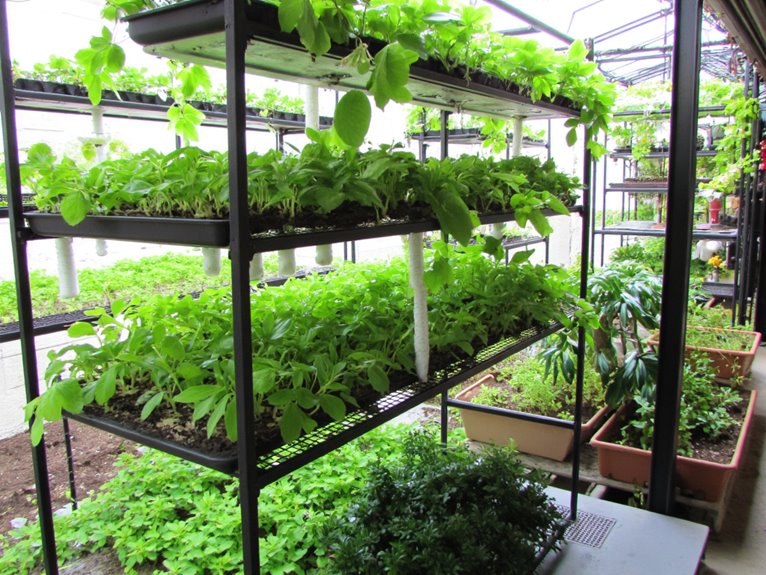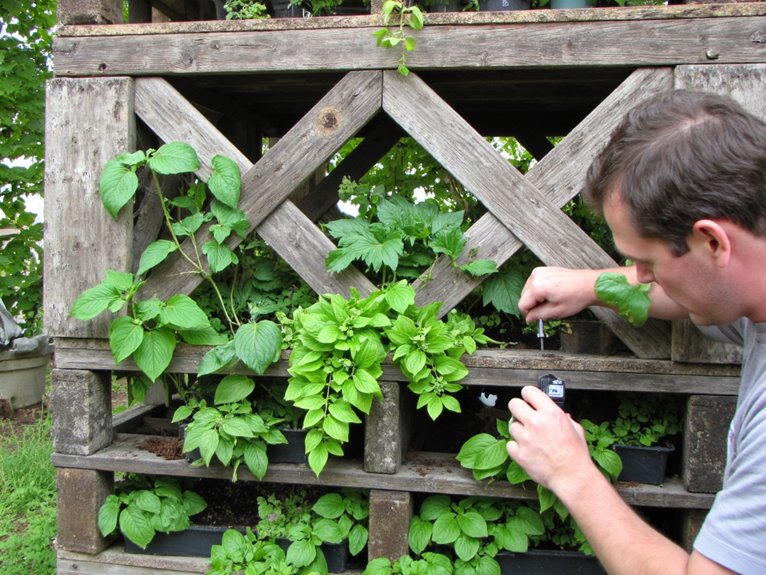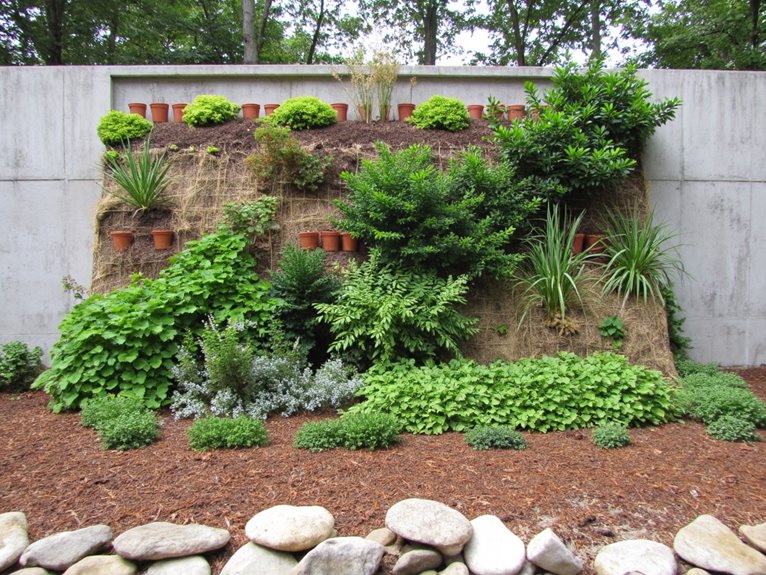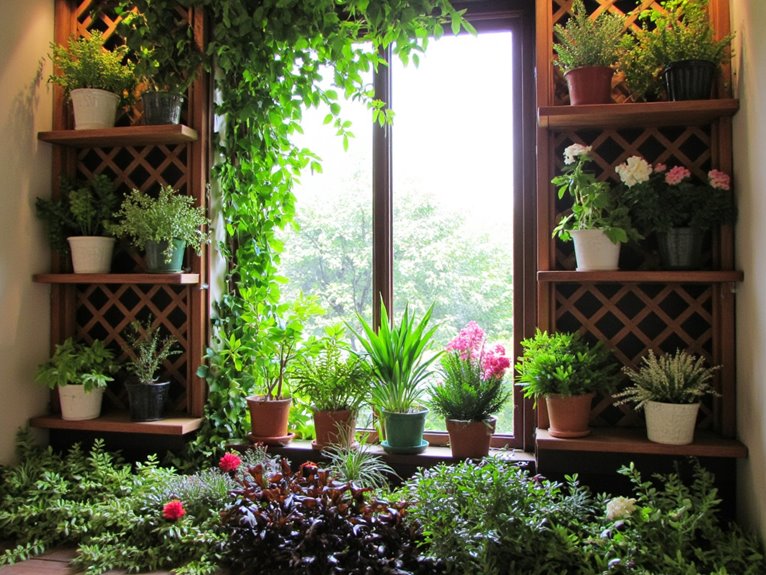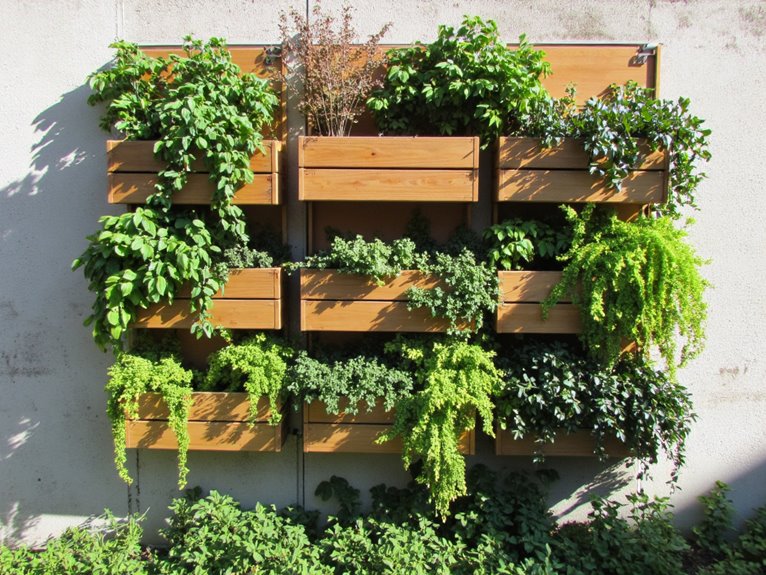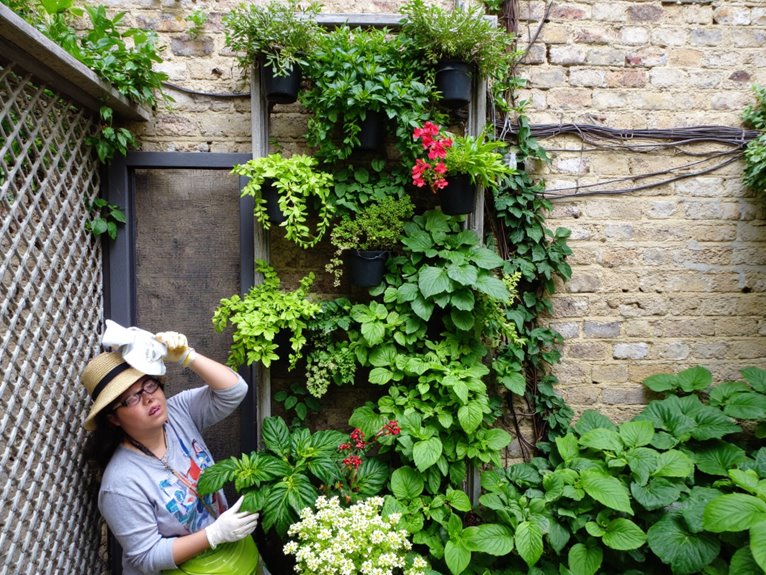Vertical Garden Plant Spacing: Proper Distance for Healthy Upward Plant Growth
When designing a vertical garden, spacing plants properly is key to healthy growth. Shallow-rooted species like lettuce or herbs do best at 12″ x 10″, while most vegetables and flowers thrive at 15″ x 15″. For taller plants or those that need good airflow, aim for 18″ apart. Always check each plant’s specific needs before arranging them. Container size and drainage also matter – make sure pots have multiple holes to prevent waterlogging. Start with a grid pattern and then adjust based on how the plants grow up. By giving each plant its own space, you’ll create a lush, layered garden that keeps producing throughout the season. As your garden grows, you’ll find new ways to keep things looking fresh and full of life.
Notable Insights
- Use tight spacing (12″ x 10″) for shallow-rooted plants to maximize vertical garden density without compromising health.
- Implement balanced spacing (15″ x 15″) to ensure proper root development and easy access for maintenance in vertical gardens.
- Maintain high-density guidelines with 18″ spacing to improve air flow, temperature regulation, and prevent fungal issues in vertical plantings.
- Apply structured layering techniques to position taller plants at the top and shorter species below in vertical garden designs.
- Regularly evaluate plant placement based on growth timelines, compatibility, and health needs for optimal vertical garden performance.
Tightest Spacing for Tropical Plants: 12” X 10” Flush Arrangement
Whether you’re working with a limited wall space or aiming to create a lush, dense tropical display, the 12″ x 10″ flush arrangement offers an excellent solution for fitting multiple plants into a compact vertical garden. This tight spacing requires careful selection of cultivars with shallow root systems to minimize root depth impact and prevent overcrowding. Humidity management techniques are essential, as dense planting can trap moisture and promote fungal issues—ensure adequate air circulation between plants. Species like philodendrons, ferns, and dianella thrive in this setup, offering varied textures without overwhelming the space. Regular pruning will maintain access to light and airflow, while drip irrigation systems help deliver consistent moisture without overwatering. Additionally, if ants become problematic in your vertical garden setup, granular treatments can be applied around the base without disrupting the tight plant arrangement. With thoughtful planning, this arrangement creates a vibrant tropical wall that maximizes greenery in minimal square footage.
Balanced Vertical Garden Layout: 15” X 15” Plant Placement
If you’re looking to balance density with accessibility in your vertical garden, the 15″ x 15″ spacing offers a smart middle ground between packed arrangements and open layouts. This optimal spacing supports root health, light distribution, and airflow while keeping plants reachable for maintenance. Implementation Challenges include planning efficient trellis systems and avoiding overcrowding during peak growing seasons.
The grid allows diverse crops like lettuce, herbs, and beans to thrive together without competing excessively for resources. You’ll need to carefully select climbing varieties that won’t shade neighbors or create wind tunnels. Regular pruning helps maintain clear pathways and prevents tangling. Consider installing solar garden lights at strategic points to illuminate your vertical setup during evening hours.
This layout’s predictability makes it ideal for container gardens or wall systems—just make sure your vertical structure accommodates both height and width requirements. With thoughtful planning, the 15″ x 15″ balance delivers abundant harvests without sacrificing plant health or garden enjoyment.
Optimal Airflow and Growth: High-Density 18” Spacing Guidelines
When you space plants 18 inches apart in vertical gardens, you’re creating conditions that support both robust growth and essential airflow—two factors that make a real difference in plant health and yield. This spacing improves air movement dynamics by reducing humidity buildup between leaves, which helps prevent fungal diseases. It also enhances temperature regulation by allowing heat to dissipate more efficiently around plants.
| Factor | Impact of 18” Spacing |
|---|---|
| Disease Risk | Lowers susceptibility to blight and mildew |
| Water Evaporation | Increases leaf drying speed after irrigation |
| Light Penetration | Guarantees even photosynthesis across canopy |
| Temperature Variation | Reduces microclimate heat pockets by 4-6°F |
| Pollinator Access | Improves visibility for bees and butterflies |
This balance prevents overcrowding stress while maximizing productivity per square foot. Apply these guidelines to grow healthier, higher-yielding vertical gardens that thrive on both density and air movement.
Enhanced Spacing Benefits
The optimal 18” spacing also promotes better root aeration in container systems, which is crucial for plants with deep taproots like tomatoes and carrots. This positioning allows each plant to develop a more extensive root system without competing excessively for soil nutrients, further supporting their vertical growth potential.
Container Selection and Drainage for Vertical Plant Health
Before you choose your containers, consider how their design will impact your vertical garden’s health—especially when it comes to water movement and root survival. Container material considerably affects root health; plastic offers durability but may degrade in extreme temperatures, while untreated wood risks rotting if not properly sealed annually. For drainage hole placement effects, multiple holes are essential to prevent waterlogging and root rot. Advanced systems like drainage boards or sand filters improve water flow and soil aeration. Always prioritize containers with adequate drainage to maintain healthy root environments. Proper drainage also ensures that liquid fertilizers can be effectively absorbed without creating harmful waterlogged conditions that prevent nutrient uptake.
Polyculture Planting Strategies Using Grid-Based Spacing
Imagine your vertical garden as a living puzzle where each plant finds its perfect spot through deliberate placement. Grid-based polyculture arranges complementary species in structured patterns that minimize nutrient competition while optimizing light distribution. By spacing plants according to their mature widths, you guarantee airflow reduces disease risk and roots access soil nutrients without overcrowding. Position tall crops on the north side to prevent shading shorter varieties, and interplant climbers with ground covers for layered growth. This approach not only maximizes yield per square foot but also creates microclimates that support diverse plant needs—ideal for growing both sun-loving herbs and shade-tolerant greens in harmony.
Height Variation Techniques to Maximize Light Exposure
In your vertical garden, height isn’t just about reaching for the sky—it’s about crafting a light ladder that feeds every leaf. Obelisk placement creates structural anchors while directing sunlight downward, perfect for shade-tolerant plants below. Reflective surface positioning redirects light to lower layers, ensuring even exposure across your garden’s elevation.
| Plant Height | Light Position |
|---|---|
| Tall (5+ft) | Lower tiers |
| Medium (3-5ft) | Mid-levels |
| Short (<3ft) | Upper shelves |
Use trellises to drape climbing plants overhead, allowing light to filter down. Pair sun-lovers with reflective materials like white mesh or glass to amplify exposure. Obelisks also act as natural light conductors, minimizing shadow overlap. Adjust placements seasonally as sunlight angles change—your garden’s height will work for you if planned thoughtfully!
Minimum Spacing Requirements for Common Garden Crops
Vertical Garden Spacing Guide
When planning your vertical garden, thoughtful spacing facilitates each plant thrives without competing for light, air, or nutrients—so take time to map out where every leaf should land. Recommended spacing ratios vary dramatically by crop family: lettuce and herbs often need just 6–12 inches, while tomatoes require 18–36 inches for vining types. Comparative plant family needs show that root crops like carrots (2–3 inches) or beets (3–4 inches) demand tighter quarters than fruiting vegetables. Always check tags for specifics, but remember vertical growth allows compact varieties to flourish closer together—especially if you’re harvesting frequently. Balance is key; too tight risks disease, while excess space wastes your garden’s potential.
Annual vs. Perennial Spacing: One Plant Per Pocket Rule
As you plan your vertical garden’s layout, balancing plant needs with space constraints becomes essential – especially when choosing between annuals and perennials. A Growth Timeline Analysis helps determine spacing: annuals grow quickly but need frequent replacement, while perennials take time to mature and spread. The Root Development Impact means perennials require more room to establish themselves. For the One Plant Per Pocket Rule, plant one perennial per pocket to avoid overcrowding as they expand over years. Annuals can be packed tighter since they’re temporary. Consider each plant’s expected size before planting – a sunflower won’t fit where clematis might thrive.
Pruning and Monitoring for Healthy Vertical Growth
Although vertical gardens offer space efficiency, their health depends on regular maintenance like pruning and monitoring. Pruning patterns for fruit bearing vines help direct energy upward, encouraging vigorous growth and higher yields. Use heading cuts to control height and slanting cuts to prevent water buildup on stems. Monitoring moisture levels in pruned structures is key—keep soil consistently damp but not soggy to avoid root rot. Regular checks also spot pests or diseases early, preserving your garden’s investment.
As plants grow, trim inward-facing branches to open up airflow and let more light reach lower leaves. This reduces fungal risks and boosts photosynthesis efficiency. Pair pruning with visual inspections for signs of stress or nutrient gaps. A well-maintained vertical garden thrives vertically, offering abundant harvests without wasting horizontal space.
Frequently Asked Questions
What Are the Best Spacing Practices for Climbing Plants?
You should space climbing plants based on their mature size—keep taller climbers away from shorter ones to avoid shading. Mix only compatible species with similar water needs. Give them at least 12-18 inches apart vertically for airflow and growth.
How Does Plant Size Affect Vertical Garden Placement?
Plant size affects vertical garden placement by influencing root depth and soil drainage needs. Larger plants require deeper containers and wider spacing to prevent overcrowding, while smaller ones can be packed closer with proper airflow. Positioning also matters – taller plants should go higher up to avoid shading lower ones.
Can I Mix Different Plant Species in a Single Planter?
Yes, you can mix plant species in a planter with proper planning. Follow companion planting rules, verify good soil drainage, choose compatible pH needs, light requirements, and growth habits. Avoid allelopathic plants. Provide enough spacing for air circulation and root development.
What Materials Are Ideal for Wall-Mounted Containers?
You should use terracotta or glass for their durability, but for weight concerns, plastic or fabric pockets work better. Avoid heavy clay mixes – opt for lightweight rock wool instead. It’s important to make sure proper drainage in all containers.
How Often Should I Prune Vertical Garden Plants?
You should prune vertical garden plants regularly, usually monthly during growing seasons and less often in dormancy. Pruning techniques like selective trimming help maintain shape and health. Seasonal trimming tips suggest early spring pruning for most plants, while some need cuts after flowering.
On a final note
By carefully spacing your plants according to their needs, you’ll create a thriving vertical garden where each plant has room to grow strong and reach its full potential. Remember that different plants require different distances—tropicals need closer packing while others need more airflow. With the right layout, containers, and companion planting techniques, you can enjoy abundant harvests or beautiful blooms all season long.
Start small, experiment with arrangements, and watch as your garden transforms into a lush, layered paradise. Your efforts will pay off in healthier plants and greater yields—both practical rewards and sources of satisfaction. Keep learning and growing alongside your garden.

